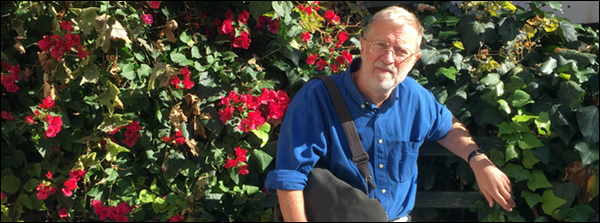Voyage to Cycladic Donoussa
“Donoussa had no roads until the 1950s. The Greek state gave the island funds to join the port at Stavros with the island’s two other main communities—Mersini on the south-east coast and Kalotaritissa in the far north. The workmen were paid 14 drachmas a day. The work was completed in 1955. Mersini is a delightful spot, the site of one of the island’s three natural springs. The spring is guarded by a huge plane tree and an elegant stone archway. It flows into a pool where four large Trump-coloured fish swim. Below the spring is a rather half-hearted garden with potatoes and cabbages: a very good place for a picnic lunch.”—By Michael House
Polemicist on Holiday
By Michael House, FRGS

KINGS SUTTON England—(Weekly Hubris)—April 2017—Last year, I failed to make my annual pilgrimage to a remote Greek island. Instead, I spent three wonderful weeks in Indian Kashmir, Ladakh, and Zanskar (see “Kashmir: Magic in Two Movements”.
This past year in October I completed my set of Mikres Cyclades or Lesser Cycadic islands with a visit to the lovely, isolated island of Donoussa, 15 miles east of Naxos.
This island appears very rarely in the writings of travelers in Greece. The only recent reference I have found is in Carola Matthews’ charming, long-out-of-print book “The Mad Pomegranate Tree: An Image of Modern Greece” (Macmillan, 1968). At one point in her book, the author appears to dismiss Donoussa as a place where “no one lives except the last remainder of its natives, where no one else will ever come to stay.” She returns to the theme later in the book, when an islander tells her “you can have a house for nothing and in 20 years you’ll be living here alone.” Happily, neither of these prophesies has come to pass.
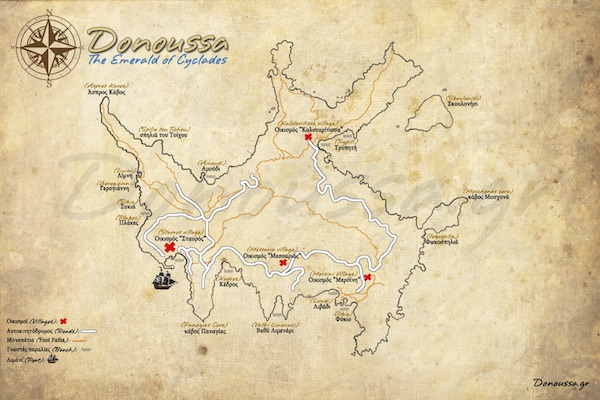
Matthews’s real purpose becomes clear when she lists Donoussa among her secret unspoilt islands. She is uncertain whether to keep the island secret, but decides that those in the know, “instead of sacrificing peasants to our dilettante whims,” should shout out to the four winds “Tourists, can you hear?” Then all may enjoy what she rightly describes as “beaches which can hardly be surpassed in Greece.”
Joseph Pitton de Tournefort (A Voyage into the Levant, 1718) was little impressed with Stenosa, as he called it. En route from Naxos to Patmos, he was blown off course. He described the island as “a scurvy dangerous rock uninhabited . . . . There is nothing in Stenosa but a sheep-fold, a sheltering-place for five or six poor goat-herds, who for fear of falling into the clutches of of the Corsairs or Banditti, betake themselves to the rocks at the at sight of the least cock-boat. Once in three months Biscuit is sent to these miserable wretches: they can hardly find water in the island, which however is fertile in fine plants . . . .” At that time, the island belonged to the monks of Amorgos, who supplied the biscuits.

No other writers have had much to say about Donoussa. Captain Denham in his book The Aegean, a sea-guide to its coasts and islands (John Murray, 1963), gives it five lines, referring to an incident in World War One, August 1914, when a German collier was allowed to shelter in the harbor, which enabled the German battle-cruisers Goeben and Breslau, en route to the Dardanelles, to refuel and thus escape pursuing British forces. They reached Constantinople, where their presence helped pressure the Turks into entering the war on the German side, thus lengthening the war by an estimated two years. One British admiral was court-marshalled as a result. Winston Churchill, First Lord of the Admiralty at the time, later wrote that the failure to intercept the cruisers brought “more slaughter, more misery and more ruin than has ever before been borne within the compass of a ship.”

The British Naval Intelligence Division Handbook for Greece, 1945, gives “Dhenousa” fairly short shrift. It is described as having an irregular shape (odd for a Greek island), scanty vegetation, an area of 5.8 square miles and a population of 235. It refers also to former copper and zinc mining. (The scars on the western hillsides are still visible.)
That’s about it, until modern guide books give Donoussa a bit of attention. Oh, I should mention that Virgil (Aeneid, Book 111) mentions Donoussa. Aeneas passed it on his way from Troy to Italy, describing it as “green.”
I flew out to Athens on October 11, and took a taxi from the airport at my wife’s insistence (I was pick-pocketed of my wallet on the Athens Metro three years ago). The fixed fare is 38 Euros. I tried out my halting Greek on my 56-year-old taxi driver, who seemed to be a Grand Prix driver manqué.
I stayed at my usual steki (hang-out) in Athens, the charming but erratic Hotel Cecil in Athinas Street, five minutes’ walk from Monastiraki Square. Settling down for the night, I rashly closed the bathroom door, only to discover the next morning that it opened only from the inside, so I had to get the desk-clerk to unlock the door.
I followed my usual routine: up at 6, I walked to the Metro (far more beggars and rough-sleepers than I remember from two years ago), and took the Metro to Piraeus, where I bought a ticket to Naxos on the Blue Star Ios from the agency opposite the station. I embarked from E7 dock, arrived on Naxos at about 1 p.m., and bought a ticket on the Express Skopelitis for 8 Euros. There was just time for a gyro for lunch, which I shared with a white kitten in a black skull-cap. Then, I hunkered down for the 4-hour sail to Donoussa, calling first at Iraklia, Schinoussa, and Koufounissi, before arriving at about 6 p.m. The Skopelitis has had a makeover. The awful lime-green interior is now decorated in restful shades of beige and brown.
I was met on the quay of the port and capital, Agios Stavros, by Loukas Vouzas, the proprietor of the excellent Makares Apartments. He is a charming man with very good English, formerly an engineer in Athens, who fell in love with the island as a child and decided to build a tourist complex. His apartments are well equipped with stoves, fridges, TV, air conditioning, and Wi-Fi. I was well looked after and strongly recommend Makares.
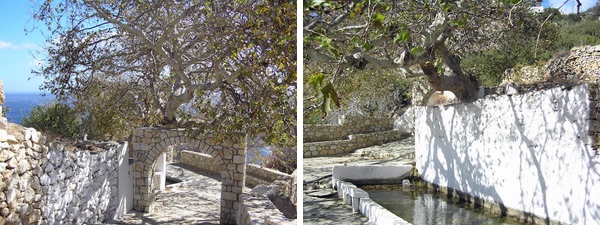
Fifteen minutes walk from the apartments, past a field full of goats, one of which was always striking a pose on a high rock, is the best beach on the island, Kendros. A paved path from the road leads down. It is a long beach of fine sand, gently shelving into the sea, ideal for families. There are lots of rocks for wall-building—my default beach activity—with shade at the far end in the morning. It is a nudist beach, practically deserted in October, apart from a few long-term hippie campers who are strong candidates for skin cancer. Behind the beach and at a discreet distance is a seasonal taverna where an excellent lunch and an early dinner may be had. It also has a small exchange library, the only source of books in English on the island.
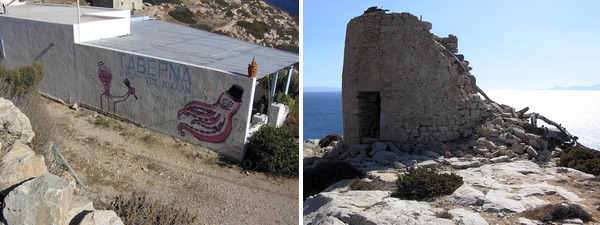
At the far end of the beach is a trail that leads to a ruined windmill (Kato Mylos) where the farmers used to mill their migadi—a mixture of wheat and barley. This is Route Number 4 of the 5 well-marked mule paths on the island. An excellent booklet in English describes the paths and what to see en route. On a still day, a sunken German warship from World War Two may be seen in the water.
Donoussa had no roads until the 1950s. The Greek state gave the island funds to join the port at Stavros with the island’s two other main communities—Mersini on the south-east coast and Kalotaritissa in the far north. The workmen were paid 14 drachmas a day. The work was completed in 1955.
Mersini is a delightful spot, the site of one of the island’s three natural springs. The spring is guarded by a huge plane tree and an elegant stone archway. It flows into a pool where four large Trump-coloured fish swim. Below the spring is a rather half-hearted garden with potatoes and cabbages: a very good place for a picnic lunch.
The village has two tavernes, both opoen only in high season, the Tzi-Tzi and the Kori Tou Michali. A good but steep path (Route 3) leads down to Livadi Beach, which is as good as Kendros, with a long strand of fine unoccupied sand. It is about 30 minutes’ walk each way from Mersini. An off-shoot path leads to a small sand beach called Fykio. I didn’t sample it because the path down runs along a cliff edge and the meltemi was blowing a gale when I was there.

The other main settlement on the island is Kalotaritissa in the north. In the shade of Mount Pappas, the highest point on the island at 385 metres (1,263 feet), it is the most attractive settlement. There is a friendly taverna, Mitsos—open through October—in the village and, if you are lucky, you will meet the local donkey. There are three beaches, only one of which, Tripiti, is worth a detour. Kendros and Livadi spoil you for other beaches. There are two ways to approach the village: the road from Mersini, and Route Number 1 from Stavros, a spectacularly beautiful hiking trail. Halfway up the trial, there are breathtaking views of Cape Aspros Kavos, the long peninsula on the north-west point of the island (Route 5). You will see a small bay that is almost a lake, Limni, which was used as the island’s main anchorage before Agios Stavros was developed.
The fourth settlement on the island is Mesaria, a rather sad collection of stone houses which was the Chora before Stavros was established. There are two parts, Ano and Kato Mesaria. It once had two active windmills. It is accessed by a path (Route 2) that starts just beyond the path down to Kedros Beach. This was once the route between Stavros and Mersini before the road was built.
The five trails cover 10.3 kilometres and were developed by the local Poseidon Cultural Association. They are well sign-posted and make the island a perfect destination for walkers.
The beach in Stavros village links the two areas of the port, the quays and shops and winding lanes on one side, and the tourist accommodation on the other. It is considered one of the best village beaches in the Cyclades.
A feature of the island is the cat population. I have never seen so many cats in one place as in Stavros. Unlike most Greek cats, they are not afraid of people and happy to be stroked. They are regularly fed, either by islanders or by diners at Captain George’s popular taverna, which I strongly recommend. I was told that one cat had cancer, and the islanders paid for treatment. The cat is now minus a pair of ears, but perfectly happy and an eager claimant at the taverna. The islanders have set up a fund to feed the cats over the winter. I saw a man with a red wheelbarrow unloading large bags of cat food from the Skopelitis one afternoon.
The Skopelitis is the lifeline of the island. When it calls from Naxos, the whole island converges to unload goods, ranging from small packages to pallets of goods on fork-lift trucks. The mini-market and the greengrocer’s are a hive of activity after the ferry arrives, restocking the shelves.
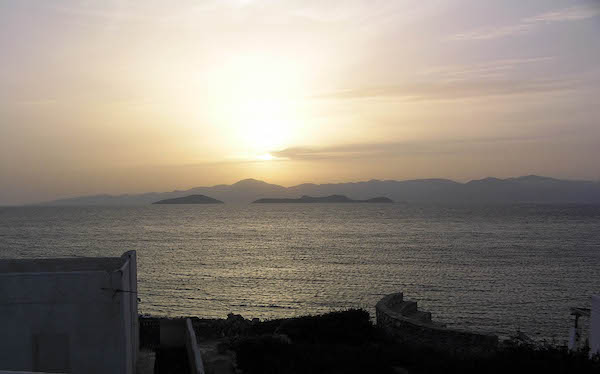
Stavros has pretty well all of the accommodation on the island. There is a post office, a cash machine, a doctor’s surgery, a bakery, a travel center and a couple of bars. The craft shop, Meli, was closed when I was there. Night-life is, happily, not a feature of the island.
October is the beginning of the quiet season here, although the weather remains perfect, but there is plenty going on in the summer. There is a music festival in June, a poetry festival at the end of August, and the usual Panagheia celebrations on August 15th.
Mid-September is a good time to visit, with the festivals of the island’s patron saint, Aghios Stavros on September 13th, Aghios Nikitas on the 15th and, at Mersini, Aghia Sofia on the 17th. These saints’ days are all excuses for a glendi, or party. There is a bus service in the summer, and caïques from the port will take you to inaccessible beaches and interesting caves.
It is hard to choose a favorite among the four inhabited islands of the Mikres Cyclades, but I can guarantee that no lover of Greece and her islands will be disappointed after a trip to Donoussa.
![]()
Editor’s Note: If you enjoyed this essay by Michael House, and are planning to visit any of Greece’s “Lesser Cyclades,” please see his essays on others in this island group at: GreeceTraveler.com.
